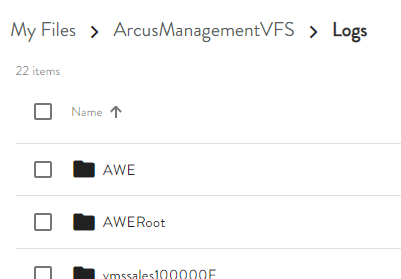EFT Arcus Logs
In the EFT Arcus Management Template, all of the log files are stored in the ArcusManagementVFS > Logs folder.

Introduction to EFT Logging
As the EFT log file subsystem writes out the date for the log, it compares the current computer date/time to the value for the log rotation (hourly/daily/weekly/monthly/yearly) period specified on the logs tab of the Server. When a write-to-log operation occurs that is calculated to cross a period (that is, the prior write was within a former period, but the current date/time at write is a new period), EFT rotates the log file name and then writes to that new log.
EFT activities can be logged in various places:
-
The main EFT activity log is saved in the Logs subdirectory of the installation directory (for example, C:\ProgramData\Globalscape\EFT Server\Logs). The file name depends on the log file format (ex, in, nc) and the date/time it was created. For example, a log file in the Microsoft IIS format created on August 22, 2007 is named in070822.log.
-
When EFT’s Download and Copy/Move Action offloads or downloads files to/from other servers, the session is recorded to a client log file: cl[yymmdd].log, e.g., cl060312.log.
-
HTTP request headers, Authentication Manager activity, and Configuration load activity, can be saved to the EFT.log file using Log4Cplus logging.
-
EFT service startup and failure events appear in the Windows Event Viewer Application Log.
-
Auditing and Reporting module (ARM) errors can be logged to a text file and viewed in the Windows Event Viewer.
-
AS2 information is logged to the ARM database.